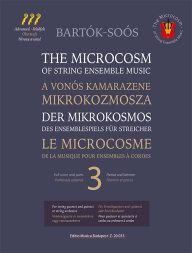The Microcosm of String Ensemble Music
based on Béla Bartók's Mikrokosmos
selected and arranged by András Soós
![]() András Soós, composer:
András Soós, composer:
It was in 1985, on the 40th anniversary of Bartók's death, that I first had the idea of making these transcriptions. The decades passed. We had to wait until the copyright expired. Before they expired, encouraged by Géza Gémesi and Ágnes Borsos, I set to work, and systematically started to write the pieces, at three different levels. In string ensemble playing, in Bartók's oeuvre, between the 44 duos and the Divertimento, there is no transition where a string player can learn his style gradually. In music school education, there's a lower level, the children's orchestra. They can play about the first 30 pieces of the first volume of Bartók's Mikrokosmos. The intermediate level is the music school string orchestra. It more or less corresponds to volumes 2, 3, and 4. Even Bartók wasn't as systematic as he had been at the beginning. We can see at least two threads. One is character pieces, the other, pieces that develop technical skills. Both are very good in music school education. Then either in the music school or at intermediate level, the next step up is the transcription for semi-professional or professional ensemble. What I found surprising was that... the pedagogical order set out by Bartók perfectly matches the order for string methods. Right up to first position, second position, third, and so on... In fact, in volume one it was easy to match the notes to various positions of the fingers in the left hand. I was able, with very few changes in the order of the pieces, to keep almost the same order that Bartók used.
![]() Péter Tornyai, composer, chamber musician:
Péter Tornyai, composer, chamber musician:
This interesting project really meets a need. The pedagogical literature for instruments starts from beginner level. And if we take the string ensemble as an instrument, there are no pieces where I can say "You should start here," and "if you work through them, you'll reach Beethoven's late quartets." You might say: the Haydn string quartets are easier, but it's not the same kind of gradual progress. The great task here is that questions of music and technique, instrumental and chamber music technique, come to the fore, in miniature. And simply. And they teach important things for the whole string quartet repertoire, not just for Bartók. One interesting contradiction is that... the most difficult pieces for a string quartet to play from this series are the simplest ones, or those with the thinnest texture. With just two parts, or one voice, in octaves, because it's so exposed, in terms of intonation and tone. These are more difficult than the pieces that more resemble works for quartet, whether by Bartók or by others. The range of players for whom this is useful is fairly broad. The pieces in volume one are good for pupils' first encounter with chamber music. Four of them sit together, maybe not a quartet, but three violins and a cello. These transcriptions cater for that too. They try them out, and experience simple but quality music. Pianists encounters these pieces in their first lessons. At the same time, the pieces in the string quartet volume can be technical studies for existing string quartets that already play together. And they work as pieces to perform, too. And they can be put in a quartet's concert programme.
![]() Ilona Dobszay-Meskó, composer, conductor:
Ilona Dobszay-Meskó, composer, conductor:
I introduced children to Bartók through improvisation. We looked at the compositional techniques in each piece. We mapped out the piece. We put away the music and tried to play something similar. We went step by step from one piece to the next. When players realize what can be done with an idea... what they can do with a partner, because we often improvised in duos, whether it's inversion, imitation, there are many techniques. We worked with it a bit, then looked to see what Bartók did. It was always a revelation to see what good things come from it. We sang many folk songs, everyone sang their favourite, and taught it to the others. But for me it was more important to see where these pieces came from. Where did these notes come from, how did the music take shape. When we were ready to give a concert of it, I think they like it, they have soaked up this music. I'm not worried about them playing Contrasts, the Concerto for Orchestra, the Divertimento, or Bluebeard, when they go to the opera. These musical phrases won't be alien to them.
Please listen to recordings of more than 40 pieces from the series:
The Microcosm of String Ensemble Music
Mikrokosmos is perhaps the 20th century's most influential set of piano pieces and one of the milestones in pedagogical piano repertoire. These 153 piano pieces, organized in ascending order of difficulty, engage not only with technical aspects of piano playing but also with the fundamentals of composition. In addition, they include character pieces and even pieces with programmatic ideas.
''The Microcosm of String Ensemble Music'' by András Soós provides 148 transcriptions from this series for making music for various string ensembles and graded in four volumes according to level of difficulty. Volumes 1 to 3 also include one copy of each part in addition to the full score. For performances with orchestra, further printed parts can be ordered individually.
The parts are also available online at www.digikotta.hu, where they can be viewed and downloaded for free as A4 PDF files using the individual code printed in the volumes.
Recordings are available at our YouTube channel.
 Deutsch
Deutsch Español
Español Français
Français Magyar
Magyar Polski
Polski Română
Română Slovenský
Slovenský Slovenščina
Slovenščina 中文
中文


